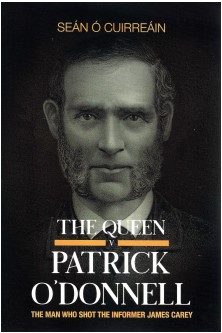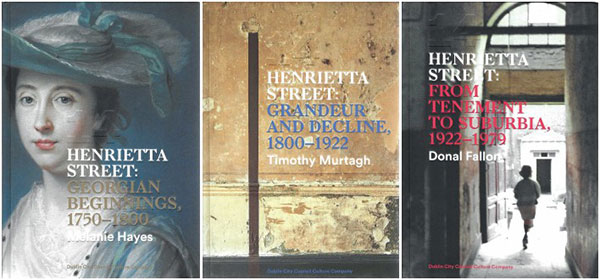BOOKWORM
Published in Book Reviews, Issue 5 (September/October 2021), Reviews, Volume 29By Joe Culley
@TheRealCulls
 No doubt you have all read the late Shane Kenna’s superb The Invincibles (Bookworm, HI 27.4, July/August 2019) on the Phoenix Park murders, and know that the culprits were apprehended when one turned State’s witness—or informer. Now Seán Ó Cuirreáin delves deeper into the aftermath with The Queen v. Patrick O’Donnell: the man who shot the informer James Carey.
No doubt you have all read the late Shane Kenna’s superb The Invincibles (Bookworm, HI 27.4, July/August 2019) on the Phoenix Park murders, and know that the culprits were apprehended when one turned State’s witness—or informer. Now Seán Ó Cuirreáin delves deeper into the aftermath with The Queen v. Patrick O’Donnell: the man who shot the informer James Carey.
O’Donnell was an intelligent but wholly illiterate labourer in his 40s from Gweedore, Co. Donegal, who had been back and forth a couple of times to America in search of his fortune. He was now headed to South Africa to start a new life, along with a woman twenty years his junior who was, variously, his wife or his niece. During the voyage to Cape Town, O’Donnell became chummy with another Irishman on board, one ‘James Power’. At the Cape, however, it emerged that ‘Power’ was none other than the traitor Carey. O’Donnell, with few apparent qualms, shot him dead and was arrested on the spot.
The killing was a propaganda coup for the Fenians and radical republicanism in general, and O’Donnell was something of a national hero (snitches get stitches). Naturally, the British authorities were concerned that similar sympathies in the colony would see O’Donnell acquitted in court, so they arranged to hold the trial in London.
The trial itself was quite the sensation, both in Britain and internationally—particularly in the US, where a defence fund had raised the equivalent of €1.5 million. The chief prosecutor was no less than the British attorney general himself, and defence counsel was the eminent Charles Russell QC, assisted, unofficially, by distinguished American lawyer General Pryor. There was also, as Ó Cuirreáin reveals for the first time, a telling intervention from the judge. Even if you know the ending, you’ll enjoy Ó Cuirreáin’s entertaining and thoroughly researched telling of the tale.
The Dublin City Culture Company, which looks after the museum at 14 Henrietta Street, has produced a handsome trilogy of slim hardbacks that tell the story of the building over 200 years by placing it firmly in the wider cultural and economic context of the various periods. It opens with Melanie Hayes and Henrietta Street: Georgian beginnings, 1750–1800, which addresses its heyday. (In March/April this year I was raving about Hayes’s The best address in town: Henrietta Street, Dublin, and its first residents, 1720–80.) Timothy Murtagh takes up the story in Henrietta Street: grandeur and decline, 1800–1922, when, for example, immediately after the Famine the house became the Encumbered Estates Court. The series closes with Donal Fallon on Henrietta Street: from tenement to suburbia, 1922–1979, which really has little to say about the house and instead focuses on the fledgling Irish state’s attempt to address the housing crisis. This includes the first planned estate, Marino/Fairview, in the 1920s, followed by the likes of Cabra and Crumlin. The series is beautifully produced, and there’s a discount if you buy from the website.

In her fascinating contribution to Medieval Dublin XVIII, Caoimhe Whelan, a research fellow at Trinity’s Long Room Hub, dissects the legend of Tristan and Isolde to see how it helped to fix Dublin within the European imagination. Isolde was, of course, the queen of Dublin, and the story of her love for the Cornish knight was the basis of the later romantic triangle of Lancelot, Guinevere and King Arthur.
In the same volume, Antoine Giacometti details one of the largest tanning complexes ever discovered in Ireland or Britain, which he unearthed in Blackpitts, off Patrick Street. Indeed, Giacometti argues that it was the pits and the foul black solution used in the tanning process that gave the area its name. I once had the (mis)fortune to be given a tour of the present-day tanning pits in Marrakesh—the stench!
The collection, edited by Seán Duffy, is a production of the Friends of Medieval Dublin, and it’s worth mentioning that they have an excellent YouTube channel, https://www.youtube.com/watch?v=G6yUKYyVZpQ, full of interesting videos. Have a look.
For the fine Four Courts series The Irish revolution, 1912–1923, well-known author and commentator Brian Feeney has tackled the events in what I might call, in the circumstances, the exceptional—even dissident—county of Antrim. The study is worth reading for the examination of the ‘Belfast Pogrom’ of 1920–2 alone. Although it is obvious once you think about it, for instance, it is still a bit counterintuitive to learn that the unionist population didn’t trust the RIC—too Catholic.
Speaking of Catholics, with his latest publication, Mission to a suffering people: Irish Jesuits 1596–1696, the indefatigable Fr Thomas J. Morrissey adds significantly to a series that has become a sort of unofficial ‘Lives of the Jesuits’. The focus here is on four men—James Archer, Richard Conway, Robert Nugent and Stephen Rice—who led the Society of Jesus during the most turbulent century for Catholics in Ireland. The action stretches from the foundation of the Irish College in Salamanca in the late 1500s through to Cromwell, the Restoration, the Glorious Revolution and the Treaty of Limerick. As ever, much of the story revolves around education, and it is all told in a clear, easy prose.
Pat McCarthy (who, incidentally, covered Waterford for the Revolution series) has produced the first full study of one of our modern economic marvels in A history of the Irish pharmaceutical industry: making medicines for the world. Though it looks and feels like a heavy academic work, McCarthy’s style means that it is accessible to the general reader with an interest in the topic. And while he details the successes, McCarthy does not shy away from the controversies, whether ecological or tax-related. McCarthy’s work is likely to serve as the standard reference for future studies, which might have a narrower focus.
The key word in the subtitle of Frank Hopkins’s enjoyable miscellany St Stephen’s Green: a history of the green and its environs: the sights, sounds, characters and events is ‘environs’, because there’s only so much material you can get out of the green itself. For instance, even on the question of the famous hangings at the green we learn that the gallows were, in fact, probably built farther down Baggot Street, near where it now meets Fitzwilliam Street. Hopkins therefore broadens his focus to the surrounding streets. Here, as expected, we find Buck Whaley and the first Earl of Clonmel, ‘Copper-faced Jack’ Scott, but we also learn about Charles Maturin, the author of Gothic classic Melmoth the Wanderer, and get the background to the Dublin Exhibition of 1865 at Coburg Gardens, now the Iveagh Gardens. On Dawson Street resided one Felicia Hemans, who wrote the poem Casabianca, remembered these days for the line ‘the boy stood on the burning deck’. There’s also a guide to the monuments within the green.

Seán Ó Cuirreáin, The Queen v. Patrick O’Donnell: the man who shot the informer James Carey (Four Courts Press, €16.15 pb, 192pp, ISBN 9781846829949).
Melanie Hayes, Henrietta Street: Georgian beginnings, 1750–1800 (Dublin City Culture Company, €18 hb, 89pp, ISBN 9780995744660).
Timothy Murtagh, Henrietta Street: grandeur and decline, 1800–1922 (Dublin City Culture Company, €18 hb, 89pp, ISBN 9780995744677).
Donal Fallon, Henrietta Street: from tenement to suburbia, 1922–1979 (Dublin City Culture Company, €18 hb, 89pp, ISBN 9780995744684).
Seán Duffy (ed.), Medieval Dublin XVIII (Four Courts Press, €45 pb, 390pp, ISBN 9781846828157).
Brian Feeney, Antrim: the Irish revolution, 1912–1923 (Four Courts Press, €22.50 pb, 192pp, ISBN 9781846828607).
Thomas J. Morrissey SJ, Mission to a suffering people: Irish Jesuits 1596–1696 (Messenger Publications, €19.95 pb, 192pp, ISBN 9781788123402).
Pat McCarthy, A history of the Irish pharmaceutical industry: making medicines for the world (Four Courts Press, €31.50 hb, 216pp, ISBN 9781846829796).
Frank Hopkins, St Stephen’s Green: a history of the green and its environs: the sights, sounds, characters and events (Mercier Press, €14.99 pb, 210pp, ISBN 9781781176924).
















